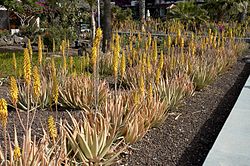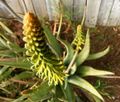Aloe vera: Difference between revisions
No edit summary |
→Gallery: added 2 images |
||
| (2 intermediate revisions by 2 users not shown) | |||
| Line 1: | Line 1: | ||
{{SPlantbox | {{SPlantbox | ||
|familia=Asphodelaceae | |||
|genus=Aloe | |genus=Aloe | ||
|species=vera | |species=vera | ||
|common_name=Aloe vera | |||
|habit=cacti-succulent | |||
|habit_ref=Flora - A Gardener's Encyclopedia | |||
|Max ht box=80 | |||
|Max ht metric=cm | |||
|height_ref=Flora - A Gardener's Encyclopedia | |||
|Min wd box=60 | |||
|Min wd metric=cm | |||
|Max wd box=120 | |||
|Max wd metric=cm | |||
|width_ref=Flora - A Gardener's Encyclopedia | |||
|lifespan=perennial | |||
|life_ref=Flora - A Gardener's Encyclopedia | |||
|exposure=sun, part-sun | |||
|sun_ref=Flora - A Gardener's Encyclopedia | |||
|water=moderate, dry | |||
|features=flowers, edible, drought tolerant | |||
|flower_season=early summer, mid summer, late summer | |||
|flower_ref=Flora - A Gardener's Encyclopedia | |||
|flowers=orange, yellow | |||
|Temp Metric=°F | |Temp Metric=°F | ||
| | |min_zone=9 | ||
|image= | |usda_ref=Flora - A Gardener's Encyclopedia | ||
|max_zone=12 | |||
|image=Aloe vera flower inset.png | |||
|image_width=240 | |image_width=240 | ||
|image_caption=''Aloe vera'' plant with flower detail inset. | |||
}} | }} | ||
'''''Aloe vera''''', also known as the '''medicinal aloe''', is a species of [[succulent plant]] that probably originated in Northern [[Africa]], the [[Canary islands]] and [[Cape Verde]]. ''Aloe vera'' grows in arid climates and is widely distributed in Africa and other arid areas. The species is frequently cited as being used in [[herbal medicine]]. | |||
Aloe vera, | |||
''Aloe vera'' is a stemless or very short-stemmed [[succulent]] plant growing to 60–100 cm (24–39 in) tall, spreading by [[offsets]]. The leaves are thick and fleshy, green to grey-green, with some varieties showing white flecks on the upper and lower stem surfaces.<ref name="Yates">Yates A. (2002) ''Yates Garden Guide''. Harper Collins Australia</ref> The margin of the leaf is [[Serrate (botany)|serrated]] and has small white teeth. The [[flower]]s are produced in summer on a spike up to {{convert|90|cm|in|abbr=on}} tall, each flower pendulous, with a yellow tubular [[Corolla (flower)|corolla]] 2–3 cm (0.8–1.2 in) long.<ref name="Yates"/><ref name="BPGE">Random House Australia ''Botanica's Pocket Gardening Encyclopedia for Australian Gardeners'' Random House Publishers, Australia</ref> Like other ''Aloe'' species, ''Aloe vera'' forms [[arbuscular mycorrhiza]], a [[symbiosis]] that allows the plant better access to mineral nutrients in soil.<ref>{{cite journal |author=Gong M, Wang F, Chen Y |title=[Study on application of arbuscular-mycorrhizas in growing seedings of Aloe vera] |language=Chinese |journal=Zhong yao cai = Zhongyaocai = Journal of Chinese medicinal materials |volume=25 |issue=1 |pages=1–3 |year=2002 |month=January |pmid=12583231 |doi= |url=}}</ref> | |||
Aloe | |||
}} | |||
{{Inc| | {{Inc| | ||
''[[Aloe]] vera'', Linn. (''A. perfoliala vera'', Linn. ''A. elongata'', Murr. ''A. barbadensis'', Mill. ''A. vulgaris''. Lam. ''A. flava'', Pers.). Cespitose, the sts. at length 1-1.5 ft. high: lvs. suberect or spreading, gradually narrowed from the base, pale, 2-3 x 12-20 in., irregularly white-blotched and narrow when young and 2-ranked on offsets, the repand margin with weak pale prickles: infl. 2-3 ft. high, often simple; fls. 1 in. long, yellow, the segms. about equaling the oblong tube. Medit. region and intro. generally through the tropics. —The source of | ''[[Aloe]] vera'', Linn. (''A. perfoliala vera'', Linn. ''A. elongata'', Murr. ''A. barbadensis'', Mill. ''A. vulgaris''. Lam. ''A. flava'', Pers.). Cespitose, the sts. at length 1-1.5 ft. high: lvs. suberect or spreading, gradually narrowed from the base, pale, 2-3 x 12-20 in., irregularly white-blotched and narrow when young and 2-ranked on offsets, the repand margin with weak pale prickles: infl. 2-3 ft. high, often simple; fls. 1 in. long, yellow, the segms. about equaling the oblong tube. Medit. region and intro. generally through the tropics. —The source of "Barbados aloes." Varies in a large Arabian form with broader lvs., taller infl., and fls. shading into orange, var. '''officinalis''', Baker (''A. officinalis'', Forsk., ''A. rubescens'', DC.); a smaller Asiatic form with red-tinged fls., var. '''chinensis''' (''A. indica'', Royle. ''A. chinensis'', Baker); and a hardier garden form of this, var. '''Lanzae''', Berger (''A. Lanzae'', Tod.). | ||
{{SCH}} | {{SCH}} | ||
}} | }} | ||
==Cultivation== | ==Cultivation== | ||
{{ | [[Image:Aloe vera A.jpg|right|thumb|200px|''Aloe vera'' can be grown as an ornamental plant.]] | ||
''Aloe vera'' has been widely grown as an ornamental plant. The species is popular with modern gardeners as a putatively [[medicinal plant]] and due to its interesting flowers, form and succulence. This succulence enables the species to survive in areas of low natural rainfall, making it ideal for rockeries and other low-water use gardens.<ref name="Yates"/> The species is hardy in [[Hardiness zone|zones]] 8–11, although it is intolerant of very heavy frost or snow.<ref name="BPGE"/><ref>{{cite web|url=http://www.bbc.co.uk/gardening/plants/plant_finder/plant_pages/7686.shtml|title=BBC Gardening, ''Aloe vera''|publisher=British Broadcasting Corporation|accessdate=2008-07-11}}</ref> | |||
In pots, the species requires well-drained sandy potting soil and bright sunny conditions. The use of a good quality commercial propagation mix or pre-packaged "cacti and succulent mix" is recommended as they allow good drainage.<ref name="GA">{{cite web|url=http://www.abc.net.au/gardening/stories/s2280641.htm|title=Fact Sheet: ''Aloes''|author=Coleby-Williams, J|publisher=Gardening Australia, Australian Broadcasting Corporation|accessdate=2008-07-08}}</ref> [[Terracotta]] pots are preferable as they are porous.<ref name="GA"/> Potted plants should be allowed to completely dry prior to re-watering. During winter, ''A. vera'' may become dormant, during which little moisture is required. In areas that receive frost or snow the species is best kept indoors or in heated glasshouses.<ref name="BPGE"/> | |||
===Propagation=== | ===Propagation=== | ||
| Line 51: | Line 50: | ||
===Pests and diseases=== | ===Pests and diseases=== | ||
{{ | The species is relatively resistant to most insect pests, though [[mealy bugs]], [[scale insects]] and [[aphid]] species may cause a decline in plant health.<ref>{{cite web|url=http://www.doacs.state.fl.us/pi/enpp/ento/a-myersi.html|title=Pest Alert: ''Aloe vera'' aphid ''Aloephagus myersi'' Essi.|publisher=[[Florida Department of Agriculture and Consumer Services]]|accessdate=2008-07-11}}</ref><ref>{{cite web|url=http://www.mobot.org/gardeninghelp/PlantFinder/plant.asp?code=B628|title=Kemper Center for Home Gardening: ''Aloe vera''|publisher=Missouri Botanic Gardens, USA|accessdate=2008-07-11}}</ref> | ||
==Species== | ==Species== | ||
| Line 57: | Line 56: | ||
==Gallery== | ==Gallery== | ||
<gallery> | <gallery> | ||
File:Aloë-vera-total.JPG|Some varieties of ''Aloe vera'' have no spots. | |||
File:Aloe_vera_in_Aruba.jpg|''Aloe vera'' growing on a roadside in [[Aruba]] | |||
File:Aloe fields.jpg|''Aloe vera'' fields | |||
File:Echte_Aloe_von_oben.JPG|Another ''Aloe vera'' plant | |||
Image:Aloe vera.jpg|Flowers | Image:Aloe vera.jpg|Flowers | ||
Image:Aloe Vera Plant Flower 2.jpg|Flowers | |||
Image:Aloe vera Plant Flower 2.jpg|Flowers | |||
Image:Aloe vera leaf.jpg|Leaf close up | Image:Aloe vera leaf.jpg|Leaf close up | ||
</gallery> | </gallery> | ||
| Line 74: | Line 75: | ||
==External links== | ==External links== | ||
*{{wplink}} | *{{wplink}} | ||
__NOTOC__ | |||
Latest revision as of 17:32, 7 June 2011
| Aloe vera subsp. var. | Aloe vera | |||||||||||||||||||||||||||||||||||||||||||||||||||||||
|---|---|---|---|---|---|---|---|---|---|---|---|---|---|---|---|---|---|---|---|---|---|---|---|---|---|---|---|---|---|---|---|---|---|---|---|---|---|---|---|---|---|---|---|---|---|---|---|---|---|---|---|---|---|---|---|---|

|
|
| ||||||||||||||||||||||||||||||||||||||||||||||||||||||
| ||||||||||||||||||||||||||||||||||||||||||||||||||||||||
Aloe vera, also known as the medicinal aloe, is a species of succulent plant that probably originated in Northern Africa, the Canary islands and Cape Verde. Aloe vera grows in arid climates and is widely distributed in Africa and other arid areas. The species is frequently cited as being used in herbal medicine.
Aloe vera is a stemless or very short-stemmed succulent plant growing to 60–100 cm (24–39 in) tall, spreading by offsets. The leaves are thick and fleshy, green to grey-green, with some varieties showing white flecks on the upper and lower stem surfaces.[1] The margin of the leaf is serrated and has small white teeth. The flowers are produced in summer on a spike up to 90 cm in tall, each flower pendulous, with a yellow tubular corolla 2–3 cm (0.8–1.2 in) long.[1][2] Like other Aloe species, Aloe vera forms arbuscular mycorrhiza, a symbiosis that allows the plant better access to mineral nutrients in soil.[3]
| Standard Cyclopedia of Horticulture |
|---|
|
Aloe vera, Linn. (A. perfoliala vera, Linn. A. elongata, Murr. A. barbadensis, Mill. A. vulgaris. Lam. A. flava, Pers.). Cespitose, the sts. at length 1-1.5 ft. high: lvs. suberect or spreading, gradually narrowed from the base, pale, 2-3 x 12-20 in., irregularly white-blotched and narrow when young and 2-ranked on offsets, the repand margin with weak pale prickles: infl. 2-3 ft. high, often simple; fls. 1 in. long, yellow, the segms. about equaling the oblong tube. Medit. region and intro. generally through the tropics. —The source of "Barbados aloes." Varies in a large Arabian form with broader lvs., taller infl., and fls. shading into orange, var. officinalis, Baker (A. officinalis, Forsk., A. rubescens, DC.); a smaller Asiatic form with red-tinged fls., var. chinensis (A. indica, Royle. A. chinensis, Baker); and a hardier garden form of this, var. Lanzae, Berger (A. Lanzae, Tod.). CH
|
Cultivation

Aloe vera has been widely grown as an ornamental plant. The species is popular with modern gardeners as a putatively medicinal plant and due to its interesting flowers, form and succulence. This succulence enables the species to survive in areas of low natural rainfall, making it ideal for rockeries and other low-water use gardens.[1] The species is hardy in zones 8–11, although it is intolerant of very heavy frost or snow.[2][4]
In pots, the species requires well-drained sandy potting soil and bright sunny conditions. The use of a good quality commercial propagation mix or pre-packaged "cacti and succulent mix" is recommended as they allow good drainage.[5] Terracotta pots are preferable as they are porous.[5] Potted plants should be allowed to completely dry prior to re-watering. During winter, A. vera may become dormant, during which little moisture is required. In areas that receive frost or snow the species is best kept indoors or in heated glasshouses.[2]
Propagation
- Do you have propagation info on this plant? Edit this section!
Pests and diseases
The species is relatively resistant to most insect pests, though mealy bugs, scale insects and aphid species may cause a decline in plant health.[6][7]
Species
Gallery
-
Some varieties of Aloe vera have no spots.
-
Aloe vera growing on a roadside in Aruba
-
Aloe vera fields
-
Another Aloe vera plant
-
Flowers
-
Flowers
-
Flowers
-
Leaf close up
References
- Standard Cyclopedia of Horticulture, by L. H. Bailey, MacMillan Co., 1963
External links
- w:Aloe vera. Some of the material on this page may be from Wikipedia, under the Creative Commons license.
- Aloe vera QR Code (Size 50, 100, 200, 500)
- ↑ 1.0 1.1 1.2 Yates A. (2002) Yates Garden Guide. Harper Collins Australia
- ↑ 2.0 2.1 2.2 Random House Australia Botanica's Pocket Gardening Encyclopedia for Australian Gardeners Random House Publishers, Australia
- ↑ Gong M, Wang F, Chen Y (January 2002). "[Study on application of arbuscular-mycorrhizas in growing seedings of Aloe vera]" (in Chinese). Zhong yao cai = Zhongyaocai = Journal of Chinese medicinal materials 25 (1): 1–3. PMID 12583231.
- ↑ "BBC Gardening, Aloe vera". British Broadcasting Corporation. Retrieved on 2008-07-11.
- ↑ 5.0 5.1 Coleby-Williams, J. "Fact Sheet: Aloes". Gardening Australia, Australian Broadcasting Corporation. Retrieved on 2008-07-08.
- ↑ "Pest Alert: Aloe vera aphid Aloephagus myersi Essi.". Florida Department of Agriculture and Consumer Services. Retrieved on 2008-07-11.
- ↑ "Kemper Center for Home Gardening: Aloe vera". Missouri Botanic Gardens, USA. Retrieved on 2008-07-11.







